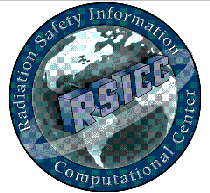
| Radiation Safety Information Computational Center | |
 |
|
| No. 395 |
November 1997
|
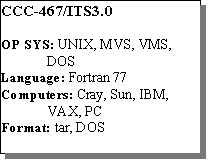 An
entry was posted in the ITS chapter of RSICC's electronic notebook on the
WWW announcing an enhancement available for use with the Sandia National
Laboratories ITS 3.0 (Integrated TIGER Series) code system for coupled
electron/photon Monte Carlo transport. ITS permits a state-of-the-art Monte
Carlo solution of linear time-integrated coupled electron/photon radiation
transport problems with or without the presence of macroscopic electric
and magnetic fields of arbitrary spatial dependence.
An
entry was posted in the ITS chapter of RSICC's electronic notebook on the
WWW announcing an enhancement available for use with the Sandia National
Laboratories ITS 3.0 (Integrated TIGER Series) code system for coupled
electron/photon Monte Carlo transport. ITS permits a state-of-the-art Monte
Carlo solution of linear time-integrated coupled electron/photon radiation
transport problems with or without the presence of macroscopic electric
and magnetic fields of arbitrary spatial dependence.
The enhancement, known as BENGAL, was developed at the University of Tennessee Space Institute (UTSI) under contract for Arnold Engineering Development Center's (AEDC) DECADE project. BENGAL is a set of UPdate Directive (UPD) files for use with the Integrated TIGER Series (ITS) of Coupled Electron/Photon Monte Carlo Transport Codes System which enhances the ITS member codes by increasing their execution speed. With the exception of the replacement of the random number generator, these enhancements give identical results to those obtained by the original ITS code. In the case of the replacement of the random number generator, the enhancement gives results with similar statistical accuracy to the original ITS code.
BENGAL works through the use of the UPdate EMuLator (UPEML) supplied with the ITS package. Through UPEML, BENGAL replaces portions of the original ITS source code with its own. This replacement code is more efficiently coded than the ITS original while maintaining the same functionality. Hence, equivalent results are obtained in less time. BENGAL replaces a number of search routines, the random number generator, and some other computationally intensive algorithms. BENGAL can also automatically customize the code's memory requirements to match the particular case being tested. This can minimize the size of the running executable; thereby increasing the speed on virtual memory systems. BENGAL can also test your 3D geometry (ACCEPT) cases to see if the geometry specifications have been accidentally redundantly encoded. This can save execution time by keeping ACCEPT from having to do calculations on geometries that have no actual bearing on the output of the case.
The readme file is posted at http://www-rsicc.ornl.gov/ENOTE/enotits.html. At this time RSICC's CCC-467/ITS3.1 code packages are not being updated, but the BENGAL enhancements are available via anonymous ftp to infosrv1.ctd.ornl.gov, cd pub/rsic/its (change mode to binary and get file for your system)
bengal.zip Files in MSDOS format compressed with PKZIP
bengal.gz Files in UNIX .tar.gz format
bengal.hqx Files in MacOS .sit.hqx format
A Fortran 77 compiler is required to run ITS on Cray computers under UNICOS operating system, on VAX under VMS, on IBM RISC 6000 under AIX, and on Sun under SunOS. The IBM PC executables were created using Lahey Fortran Compiler F77L-EM/32 Version 5.0, which incorporates the PharLap DOS extender. The executables produced by this compiler are compatible with Windows and will run in background with an appropriate setup. The package is transmitted on DOS diskettes (1.44 MB) in self-extracting DOS files, which contain the source codes and test cases. References: SAND91-1634 (March 1992), SAND92-0073, UC-705 (April 1992). Fortran 77; Cray, IBM, VAX (C00467/MFMWS/00); PC486 (C00467/PC486/01).
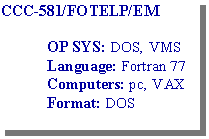 The
Institute of Nuclear Sciences "Vinca" Nuclear Engineering Laboratory "NET"
Beograd, Yugoslavia, contributed a newly frozen version of this code system
to compute photon/electron/positron radiation transport problems in three
dimensions with or without the presence of macroscopic electric and magnetic
fields for dosimetry, radiation damage, radiation therapy and other applications.
Physical rigor is maximized by employing the available cross sections and
sampling distributions, and the most complete physical model for describing
the transport and production of the photon/electron/positron cascade from
20.0 MeV down to 1.0 keV. The condensed history Monte Carlo method (Berger
1963) is used for the electron and positron transport simulation. During
a history the particles lose energy in collisions, and the secondary particles
are generated on the step according to the probabilities for their occurrence.
Electron (positron) energy loss is through inelastic electron-electron
(e-,e-) and positron-electron (e+,e-) collisions and bremsstrahlung generation.
The
Institute of Nuclear Sciences "Vinca" Nuclear Engineering Laboratory "NET"
Beograd, Yugoslavia, contributed a newly frozen version of this code system
to compute photon/electron/positron radiation transport problems in three
dimensions with or without the presence of macroscopic electric and magnetic
fields for dosimetry, radiation damage, radiation therapy and other applications.
Physical rigor is maximized by employing the available cross sections and
sampling distributions, and the most complete physical model for describing
the transport and production of the photon/electron/positron cascade from
20.0 MeV down to 1.0 keV. The condensed history Monte Carlo method (Berger
1963) is used for the electron and positron transport simulation. During
a history the particles lose energy in collisions, and the secondary particles
are generated on the step according to the probabilities for their occurrence.
Electron (positron) energy loss is through inelastic electron-electron
(e-,e-) and positron-electron (e+,e-) collisions and bremsstrahlung generation.
FOTELP/EM runs on either IBM PC or VAX computers. A Fortran 77 compiler is required to create executables on the VAX. The FOTELP/EM package can be installed and run on a PC with at least 8 MB of RAM under MS-DOS 6 or WINDOWS 3.1 and higher. The DEC Visual Fortran 90 compiler was used to build the executables which are included. The package is transmitted on two DS/HD 3.5-in. (1.44 MB) diskettes. Reference: NET-87 (1996). Fortran 77; PC 486 or VAX (C00581/IBMPC/00).
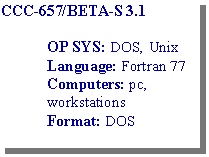 Atomic
Energy of Canada Limited, Whiteshell Laboratories, contributed a code system
to calculate multigroup beta-ray spectra. BETA-S calculates beta-decay
source terms and energy spectra in multigroup format for time-dependent
radionuclide inventories of actinides, fission products, and activation
products. Multigroup spectra may be calculated in any arbitrary energy-group
structure. The code also calculates the total beta energy release rate
from the sum of the average beta-ray energies as determined from the spectral
distributions. BETA-S also provides users with an option to determine principal
beta-decaying radionuclides contributing to each energy group. Nuclide
inventories are obtained from a binary interface produced by the ORIGEN-S
(CCC-545) code. BETA-S calculates the spectra for all isotopes on the binary
interface that have associated beta-decay transition data, which were developed
for the BETA-S code and are based on the Evaluated Nuclear Structure Data
Files maintained by NNDC at Brookhaven National Laboratory. This library
was generated from ENSDF data and contains 715 materials representing approximately
8500 individual beta transition branches.
Atomic
Energy of Canada Limited, Whiteshell Laboratories, contributed a code system
to calculate multigroup beta-ray spectra. BETA-S calculates beta-decay
source terms and energy spectra in multigroup format for time-dependent
radionuclide inventories of actinides, fission products, and activation
products. Multigroup spectra may be calculated in any arbitrary energy-group
structure. The code also calculates the total beta energy release rate
from the sum of the average beta-ray energies as determined from the spectral
distributions. BETA-S also provides users with an option to determine principal
beta-decaying radionuclides contributing to each energy group. Nuclide
inventories are obtained from a binary interface produced by the ORIGEN-S
(CCC-545) code. BETA-S calculates the spectra for all isotopes on the binary
interface that have associated beta-decay transition data, which were developed
for the BETA-S code and are based on the Evaluated Nuclear Structure Data
Files maintained by NNDC at Brookhaven National Laboratory. This library
was generated from ENSDF data and contains 715 materials representing approximately
8500 individual beta transition branches.
BETA-S has been installed and verified on IBM RS/6000 and HP-750 workstations. Porting to any platform for which the SCALE system is available should require minimal effort. BETA-S has been installed on Unix and MS-DOS operating systems. A Fortran 77 compiler is required. No executables are included in this distribution. Several C language utility routines, primarily for system quality assurance functions, are obtained from the SCALE subroutine library for the Unix version. The CCC-545/SCALE 4.3 (or SCALE4.2) code system must be installed on the computer before installing BETA-S, which requires the SCALE subroutine library and nuclide-inventory generation from the ORIGEN-S code. The package is transmitted on one DS/HD 3.5-in. (1.44 MB) DOS diskette in a PKZIP archive file which includes the BETA-S source files, ENSDF-95 library, test cases, PC batch files, and information files. Reference: RC-1564 (COG-93-33-I) (1996). Fortran 77; IBM RS/6000, HP 750, PC 486 (C00657/MNYCP/00).
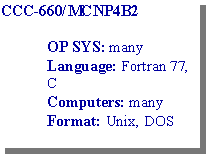 Los
Alamos National Laboratory, Los Alamos, New Mexico, contributed a correction
for MCNP4B which supports Linux and Lahey Fortran 90 on PCs, includes a
fix for PVM, and corrects a potentially significant problem which affects
all repeated structures/lattice geometry problems with closely spaced surfaces.
MCNP4B is a general-purpose, continuous-energy, generalized geometry, time-dependent,
coupled neutron-photon-electron Monte Carlo transport code system. The
correction, which is a replacement for the install.fix file, is posted
on the internet at http://www-xdiv.lanl.gov/XTM/world/fix4b.970723
and may be downloaded by MCNP4B users. Alternately, the new or modified
files in RSICC's master may be downloaded via anonymous ftp to infosrv1.ctd.ornl.gov
in file pub/rsic/mcnp4b/fix4b2.exe. Note that plotting is not available
with Lahey F90 because no graphics library is distributed with this compiler.
PC executables for makxsf and prpr were added to the RSICC master and also
to the updates posted on the www. The MCNP4B executables were not replaced
in RSICC's master, and test case results are not impacted by the correction.
Los
Alamos National Laboratory, Los Alamos, New Mexico, contributed a correction
for MCNP4B which supports Linux and Lahey Fortran 90 on PCs, includes a
fix for PVM, and corrects a potentially significant problem which affects
all repeated structures/lattice geometry problems with closely spaced surfaces.
MCNP4B is a general-purpose, continuous-energy, generalized geometry, time-dependent,
coupled neutron-photon-electron Monte Carlo transport code system. The
correction, which is a replacement for the install.fix file, is posted
on the internet at http://www-xdiv.lanl.gov/XTM/world/fix4b.970723
and may be downloaded by MCNP4B users. Alternately, the new or modified
files in RSICC's master may be downloaded via anonymous ftp to infosrv1.ctd.ornl.gov
in file pub/rsic/mcnp4b/fix4b2.exe. Note that plotting is not available
with Lahey F90 because no graphics library is distributed with this compiler.
PC executables for makxsf and prpr were added to the RSICC master and also
to the updates posted on the www. The MCNP4B executables were not replaced
in RSICC's master, and test case results are not impacted by the correction.
MCNP4B2 includes a test library of cross sections for running the sample problems; but all cross sections are included in the new DLC-189/MCNPXS code package, which is distributed with the code. MCNP4B is operable on Cray computers under UNICOS using CFT77 6.0.4.1, IBM RS/6000 under AIX 3.2.5 and AIX 4.2, SunSparc under SOLARIS 2.4 using F77 4.0, DEC Alpha under Digital UNIX V3.2, HP with HP F77 9.16, SGI under IRIX 4.0.2, Linux, and all computers in general with at least 150 megabytes of hard disk. Executable files for the PC version are provided for running on 32MB memory on either a Pentium or 80486 computer with a coprocessor. The PC executables included in the package were created with the Lahey Fortran F77L3-EM/32 version 5.2 compiler. They run in a DOS window of either Windows95 or WindowsNT 4.0. Compilation of MCNP under Unix requires both Fortran 77 and ANSI C standard compilers. PVM is required for multiprocessing on a cluster of workstations. Scripts are provided for installation on both PC and Unix systems. Included are the referenced documents and the source codes, test problems, executables, and installation scripts available on a UNIX tar format cartridge tape or CD-ROM for use on both Unix and DOS platforms. References: LA-12625-M (1997), LA-13181 (August 1996), and LA-13138 (April 1996). Fortran 77 and C; Unix workstations, Intel-based PC, and Cray (C00660/ALLCP/01).
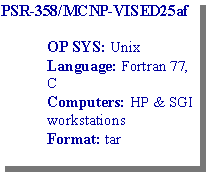 Battelle
Pacific Northwest National Laboratory, Richland, Washington, contributed
this visual editor for creating MCNP4A input files. MCNP was developed
at Los Alamos National Laboratory. MCNP-VISED25af enables a visual creation
of an MCNP input file. Up to 10 dynamic cross sectional views of the geometry
can be utilized to create surfaces and build the geometry. Surfaces appear
on the plots as soon as they are created - before they are used in the
definition of cells. Surface and cell creation are implemented with flexible
menus that also allow for ease of modification and rapid creation of similar
sets of surfaces and cells. Universes, fills, lattices and transformations
are allowed. Senses of portions of cells are designated with the mouse
for paste and cut operations. A cell splitting option can be used to split
certain types of regions [a slab region, the region between two concentric
spheres or cylinders, or a box-in-box region] into n cells with
n input by the user. The user can also obtain on-line dynamic views
of the source points created from the source description as a further verification
of the description of the source. Helps are included to aid in the creation
of rectangular and hexagonal lattices including the generation of the surfaces
and tools for creating and modifying the fill matrix. Data cards that can
be created include materials, transformations and importances. An input
file, or backup, can be created at any time during the visual editing session.
Partially completed input files can be read in to continue with another
editing session. MCNP input files created by VISED can be read by either
CCC-200/MCNP4A or CCC-660/MCNP4B; however, VISED will not recognize new
MCNP4B features.
Battelle
Pacific Northwest National Laboratory, Richland, Washington, contributed
this visual editor for creating MCNP4A input files. MCNP was developed
at Los Alamos National Laboratory. MCNP-VISED25af enables a visual creation
of an MCNP input file. Up to 10 dynamic cross sectional views of the geometry
can be utilized to create surfaces and build the geometry. Surfaces appear
on the plots as soon as they are created - before they are used in the
definition of cells. Surface and cell creation are implemented with flexible
menus that also allow for ease of modification and rapid creation of similar
sets of surfaces and cells. Universes, fills, lattices and transformations
are allowed. Senses of portions of cells are designated with the mouse
for paste and cut operations. A cell splitting option can be used to split
certain types of regions [a slab region, the region between two concentric
spheres or cylinders, or a box-in-box region] into n cells with
n input by the user. The user can also obtain on-line dynamic views
of the source points created from the source description as a further verification
of the description of the source. Helps are included to aid in the creation
of rectangular and hexagonal lattices including the generation of the surfaces
and tools for creating and modifying the fill matrix. Data cards that can
be created include materials, transformations and importances. An input
file, or backup, can be created at any time during the visual editing session.
Partially completed input files can be read in to continue with another
editing session. MCNP input files created by VISED can be read by either
CCC-200/MCNP4A or CCC-660/MCNP4B; however, VISED will not recognize new
MCNP4B features.
This menu-driven graphical interface is based on C-language routines that interface with the screen and call Fortran subroutines which initialize the input data and prepare the information for the geometry plots. These Fortran routines in turn call slightly modified Fortran subroutines from the initiation and plot modules of MCNP version 4A. These Fortran subroutines constantly check the evolving input data being received from the C routines and generate the information for dynamically plotting the geometry in user-selected cross-sectional views. The widgets are created in Motif, the graphics are created using Xlib routines. VISED runs on HP or SGI workstations with at least 30 Mbytes of memory. MCNP-VISED will not run on other systems. Smaller memory limits are allowed if the code is recompiled with mdas reduced. Fortran and ANSI-C compilers with access to the Xlib and Motif libraries are required to build executables. HP and SGI executables are included in the package but are not guaranteed to run due to variations in system configurations. The package is transmitted on either CD-ROM or cartridge tape in a compressed Unix tar file. Reference: unpublished Battelle Pacific Northwest National Laboratory report (October 1997). HP and SGI; Fortran 77 and C (P00358/MNYWS/00).
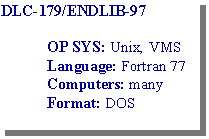 Lawrence
Livermore National Laboratory, Livermore, California, contributed a newly
frozen version of the evaluated photon interaction data library designated
EPDL97. EPDL97 replaced EPDL89 in this package of atomic data, electron
data, and photon data in Evaluated Nuclear Data Library (ENDL) type format.
It is highly recommended that only the most recent version of this library
be used. The present form is a machine-independent character file format
and contains data for the evaluated atomic relaxation data library (EADL),
the evaluated photon interaction data library (EPDL), and the evaluated
electron interaction data library (EEDL). Additions to the package include
1) the ENDL-formatted EXDL file of evaluted excitation data, which includes
data to describe photoexcitation lines and, 2) the ENDF/B-VI photon interaction
library. Note that the cross sections in the ENDF-B6 format are the same
as those in the ENDL-formatted EPDL97 file.
Lawrence
Livermore National Laboratory, Livermore, California, contributed a newly
frozen version of the evaluated photon interaction data library designated
EPDL97. EPDL97 replaced EPDL89 in this package of atomic data, electron
data, and photon data in Evaluated Nuclear Data Library (ENDL) type format.
It is highly recommended that only the most recent version of this library
be used. The present form is a machine-independent character file format
and contains data for the evaluated atomic relaxation data library (EADL),
the evaluated photon interaction data library (EPDL), and the evaluated
electron interaction data library (EEDL). Additions to the package include
1) the ENDL-formatted EXDL file of evaluted excitation data, which includes
data to describe photoexcitation lines and, 2) the ENDF/B-VI photon interaction
library. Note that the cross sections in the ENDF-B6 format are the same
as those in the ENDL-formatted EPDL97 file.
These libraries span atomic numbers, Z, from 1 to 100 including: photoionization, photoexcitation, coherent and incoherent scattering, and pair and triplet production cross sections. EPDL97 covers the incident particle energy range from 1 eV to 100 GeV.
The ASCII card images are transmitted as a tar file on CD-ROM. References:
UCRL-50400, Vo. 6, Rev. 5 (Sept. 1997), UCRL-ID-117796 (July 1994), UCRL-ID-110438
(March 1992), and UCRL-ID-103422 (November 1989). Fortran 77; VAX (D00179/MNYCP/01).
RSICC attempts to keep its users/contributors advised of conferences, courses, and symposia in the field of radiation protection, transport, and shielding through this section of the newsletter. Should you be involved in the planning/organization of such events, feel free to send your announcements and calls for papers via email to raf@ornl.gov.

The Second International Topical Meeting on Nuclear Applications of Accelerator Technology (AccApp'98) is sponsored by the Accelerator Applications Technical Group of the American Nuclear Society (ANS), and is hosted by the Oak Ridge-Knoxville, Tennessee, USA Section of the ANS. It will be held in Gatlinburg, Tennessee, during the week of September 20-23, 1998, at the Park Vista Hotel & Conference Center.
AccApp'98 will provide a forum for discussion of the uses of particle accelerator technology for nuclear applications. It will focus on production of neutrons and other particles, utilization of these particles for scientific or industrial purposes, production or destruction of radionuclides significant to energy, medicine, defense, or other endeavors, as well as imaging and diagnostics.
Papers are solicited in the following areas: applications, design, R&D needs, analytical methods, tools and databases, economics, safety and licensing. The Call For Papers with all relevant information and points of contact is attached to the end of this newsletter.
Your attention is directed to the following events of interest.
December 1997
International Conference and Exhibition "Plant Life Management and
Plant Life Extension in Nuclear Facilities," Dec. 8-10, 1997, Prague,
Czech Republic, organized by Nuclear Engineering International. Contact:
Alan Wagstaff, Events Manager, Nuclear Engineering International, Wilmington
Publishing, Wilmington House, Church Hill, Wilmington, Dartford, Kent,
DA2 7EF, UK (phone 44-1322-277788, fax 44-1322-273748).
January 1998
X-Ray Mammography, Basic Physics and Quality Assurance, Jan. 12-13, 1998, a continuing education course offered by the University of Texas at San Antonio. Contact: The University of Texas Health Science Center at San Antonio, Continuing Medical Education, 7703 Floyd Curl Dr., San Antonio, TX 78284-7980 (phone 210-567-4491; fax 210-567-6964).
Medical Radiation Safety Physics, Jan. 14, 1998, a continuing education course offered by the University of Texas at San Antonio. Contact: The University of Texas Health Science Center at San Antonio, Continuing Medical Education, 7703 Floyd Curl Dr., San Antonio, TX 78284-7980 (phone 210-567-4491; fax 210-567-6964).
Diagnostic Medical Physics, Jan. 15, 1998, a continuing education course offered by the University of Texas at San Antonio. Contact: The University of Texas Health Science Center at San Antonio, Continuing Medical Education, 7703 Floyd Curl Dr., San Antonio, TX 78284-7980 (phone 210-567-4491; fax 210-567-6964).
Radiation Oncology Physics, Jan. 16, 1998, a continuing education course offered by the University of Texas at San Antonio. Contact: The University of Texas Health Science Center at San Antonio, Continuing Medical Education, 7703 Floyd Curl Dr., San Antonio, TX 78284-7980 (phone 210-567-4491; fax 210-567-6964).
Nuclear Medicine Physics, Jan. 17, 1998, a continuing education course offered by the University of Texas at San Antonio. Contact: The University of Texas Health Science Center at San Antonio, Continuing Medical Education, 7703 Floyd Curl Dr., San Antonio, TX 78284-7980 (phone 210-567-4491; fax 210-567-6964).
Radiation Safety Officer's Course, Jan. 19-23, 1998, a continuing education course offered by the University of Texas at San Antonio. Contact: The University of Texas Health Science Center at San Antonio, Continuing Medical Education, 7703 Floyd Curl Dr., San Antonio, TX 78284-7980 (phone 210-567-4491; fax 210-567-6964).
February 1998
Health Physics Society Midyear Topical Meeting, Feb. 8-11, 1998, Mobile, Alabama. Contact: Health Physics Society, Suite 402, 1313 Dolley Madison Blvd., McLean, VA 22101-3926 (phone 703-790-1745; fax 703-790-2672; email: hpsburkmgt@aol.com).
Medical Dosimetry Review, Feb. 23-27, 1998, a continuing education course offered by the University of Texas at San Antonio. Contact: The University of Texas Health Science Center at San Antonio, Continuing Medical Education, 7703 Floyd Curl Dr., San Antonio, TX 78284-7980 (phone 210-567-4491; fax 210-567-6964).
April 1998
34th Annual Meeting of the National Council on Radiation Protection
and Measurements, Apr. 1-2, 1998, Arlington, VA. Contact: National
Council on Radiation Protection and Measurements, Suite 800, 7910 Woodmont
Ave., Bethesda, MD 20814-3095 (phone 301-657-2652).
Technologies for the New Century, 1998 ANS Radiation Protection and Shielding Division Topical Conference, Apr. 19-23, 1998, Nashville, Tennessee. Contact: Dan T. Ingersoll, Oak Ridge National Laboratory, P.O. Box 2008, Oak Ridge, TN 37831-6363 (fax 423-574-9619).
May 1998
Radiation Oncology Resident's Review in Radiation Oncology Physics and Radiation Biology, May 11-15, 1998, a continuing education course offered by the University of Texas at San Antonio. Contact: The University of Texas Health Science Center at San Antonio, Continuing Medical Education, 7703 Floyd Curl Dr., San Antonio, TX 78284-7980 (phone 210-567-4491; fax 210-567-6964).
Physicist's Review in Radiation Oncology Physics, May 11-15, 1998, a continuing education course offered by the University of Texas at San Antonio. Contact: The University of Texas Health Science Center at San Antonio, Continuing Medical Education, 7703 Floyd Curl Dr., San Antonio, TX 78284-7980 (phone 210-567-4491; fax 210-567-6964).
Computational Methods in Reactor Analysis and Shielding, May 18-22, 1998, Knoxville, Tennessee, a short course offered by the University of Tennessee-Knoxville. Contact: Lydia Salmon, Dept. of Nuclear Engineering, University of Tennessee, Knoxville, TN 37996 (phone 423-974-2525; email lsalmon@utk.edu).
Nuclear Criticality Safety, May 18-22, 1998, Knoxville, Tennessee, a short course offered by the University of Tennessee-Knoxville. Contact: Lydia Salmon, Dept. of Nuclear Engineering, University of Tennessee, Knoxville, TN 37996 (phone 423-974-2525; email lsalmon@utk.edu).
Monte Carlo Analysis, May 18-22, 1998, Knoxville, Tennessee, a short course offered by the University of Tennessee-Knoxville. Contact: Lydia Salmon, Dept. of Nuclear Engineering, University of Tennessee, Knoxville, TN 37996 (phone 423-974-2525; email lsalmon@utk.edu).
Radiation Safety Officer's Course, May 18-22, 1998, a continuing education course offered by the University of Texas at San Antonio. Contact: The University of Texas Health Science Center at San Antonio, Continuing Medical Education, 7703 Floyd Curl Dr., San Antonio, TX 78284-7980 (phone 210-567-4491; fax 210-567-6964).
June 1998
3rd International Meeting of Physicists in the Inca Region, June 15-20, 1998, Cusco, Peru. Contact: Jon Broadway, Internatl. Corps on Environment (ICE), Auburn University, 75 Technacenter Drive, Montgomery, AL 36117-6035 (phone: 334-242-2777; fax: 334-242-2755; email: broadway@strudel.aum.edu).
July 1998
Health Physics Society Annual Meeting, July 12-16, 1998, Minneapolis, Minnesota. Contact: Health Physics Society, Suite 402, 1313 Dolley Madison Blvd., McLean, VA 22101-3926 (phone 703-790-1745; fax 703-790-2672; email: hpsburkmgt@aol.com).
September 1998
AccApp'98, Sept. 20-23, 1998, Gatlinburg, Tennessee, sponsored by the Oak Ridge-Knoxville, TN, USA Section of the ANS. Contact: Dr. John Haines, Chairman, AccApp '98 Technical Program Committee, Oak Ridge National Laboratory, Oak Ridge, TN 37831-8071 , USA (phone 423-574-0966 Fax: 423-576-7926, email: hainesjr@ornl.gov), or http://www.engr.utk.edu/org/ans/AccApp98
June 1999
Conference on Radionuclide Metrology and its Application, June
7-11, 1999, Prague. Contact: Pavel Dryák, Czech Metrological Institute,
Radiova 1, CZ 102 00 Prague, Czech Republic (phone: +420 2 67008244, fax:
+420 2 67008466, email: pdryak@cmi.cz).
The following literature cited has been reviewed and placed in the RSICC Information Storage and Retrieval Information System (SARIS), now searchable on the RSICC web server (http://www-rsicc.ornl.gov/rsic.html). This early announcement is made as a service to the shielding community. Copies of the literature are not distributed by RSICC. They may generally be obtained from the author or from a documentation center such as the National Technical Information Service (NTIS), Department of Commerce, Springfield, Virginia 22161. For literature listed as available from INIS contact INIS Clearinghouse, International Atomic Energy Agency, P.O. Box 100, A-1400 Vienna.
Health Phys., 73, 601-610 . . . Individual Quantification of 89Sr and 90Sr in Nuclear Reactor Effluent. . . . Senaratne, U.P.M.; Jester, W.A.; Bleistein, C.D. . . . October 1997 . . . Penn State University, University Park, PA; CB Tech, Valley Forge, PA.
Health Phys., 73, 611-619 . . . Fifty Years of Plutonium Exposure to the Manhattan Project Plutonium Workers: An Update. . . . Voelz, G.L.; Lawrence, N.P.; Johnson, E.R. . . . October 1997 . . . Los Alamos National Laboratory, Los Alamos, NM.
Health Phys., 73, 620-628 . . . Dose Reconstruction for Weapons Experiments Involving 140La at Los Alamos National Laboratory, 1944-1962. . . . Kraig, D.H. . . . October 1997 . . . Los Alamos National Laboratory, Los Alamos, NM.
Health Phys., 73, 629-632 . . . Relative Performance of Different Types of Passive Dosimeters Employing Solid State Nuclear Track Detectors. . . . Jamil, K.; Al-Ahmady, K.K.; Rehman, F.; Ali, S.; Qureshi, A.A.; Khan, H.A. . . . October 1997 . . . PINSTECH, Islamabad, Pakistan.
Health Phys., 73, 639-643 . . . A New Approach for the Calculation of Photon Dose Conversion Factors in the PMMA Slab Phantom. . . . Jong Oh Kim; Jong Kyung Kim . . . October 1997 . . . Hanyang University, Seoul, Korea.
Survey of the 137Cs Contamination in Belgium by In-Situ Gamma Spectrometry, A Decade After the Chernobyl Accident. . . . . . October 1997 . . . University Gent, Gent, Belgium; Belgian Nuclear Research Centre, Boeretang, Belgium; A. V. Nuclear, Brussels, Belgium.
Health Phys., 73, 647-650 . . . 129I, 131I and 127I in Animal Thyroids After the Chernobyl Nuclear Accident. . . . VanMiddlesworth, L.; Handl, J. . . . October 1997 . . . University of Tennessee, Memphis, TN; Zentrum fur Strahlenschutz und Radiookologie Universitat Hannover, Hannover, Germany.
Health Phys., 73, 651-662 . . . An Estimate by Two Methods of Thyroid Absorbed Doses Due to Bravo Fallout in Several Northern Marshall Islands. . . . Musolino, S.V.; Greenhouse, N.A.; Hull, A.P. . . . October 1997 . . . Brookhaven National Laboratory, Upton, NY.
Health Phys., 73, 694-695 . . . Impact of the 235U Series on Doses from Intakes of Natural Uranium and Decay Progeny. . . . Lowe, L.M. . . . October 1997 . . . Senes Consultants Limited, Richmond Hill, Ontario, Canada.
Health Phys., 73, 735 . . . New HTML and the Web. . . . Busby, B. . . . November 1997.
Health Phys., 73, 747-755 . . . Placental Transfer of Radiopharmaceuticals and Dosimetry in Pregnancy. . . . Russell, J.R.; Stabin, M.G.; Sparks, R.B. . . . November 1997 . . . Holtec International, Marlton, NJ; Oak Ridge Institute for Science and Education, Oak Ridge, TN.
Health Phys., 73, 756-769 . . . Radiation Absorbed Dose to the Embryo/Fetus from Radiopharmaceuticals. . . . Russell, J.R.; Stabin, M.G.; SZx parks, R.B.; Watson, E. . . . November 1997 . . . Holtec International, Marlton, NJ; Oak Ridge Associated Universities, Oak Ridge, TN.
Health Phys., 73, 779-786 . . . Evaluation of Possible Population Bias Among High-Dose Atomic Bomb Survivors in the Frequency of the HLA-DQA1 Allele and Dr Antigen Types. . . . Hayashi, T.; Kusunoki, Y.; Seyama, T.; Hirai, Y.; Kyoizumi, S.; Akiyama, M.; Nakamura, N.; D . . . November 1997 . . . Radiation Effects Research Foundation, Hiroshima, Japan.
Health Phys., 73, 800-807 . . . Groundwater Activation at the Superconducting Super Collider: A New Design Model. . . . Bull, J.S.; Romero, V.D.; Baker, S.I.; Stapleton, G.B.; Goss, D.L.; Coulson, L.V. . . . November 1997 . . . Superconducting Super Collider Laboratory, Waxahachie, TX; Nebraska Wesleyan University, Lincoln, NE.
Nucl. Sci. Eng., 126, 1-18 . . . Assigning Uncertainties to Scientific Data. . . . Frohner, F.H. . . . May 1997 . . . Forschungszentrum Karlsruhe, Karlsruhe, Germany.
Nucl. Sci. Eng., 126, 19-34 . . . Space-Dependent Resonance Self-Shielding. . . . Williams, M.L.; Raharjo, R. . . . May 1997 . . . Louisiana State University, Baton Rouge, LA.
Nucl. Sci. Eng., 126, 35-47 . . . Extension of Analytic Function Expansion Nodal Method to Multigroup Problems in Hexagonal-Z Geometry. . . . Nam Zin Cho; Yong Hee Kim; Keon Woo Park . . . May 1997 . . . Korea Advanced Institute of Science and Technology, Taejon, Korea.
Nucl. Sci. Eng., 126, 48-58 . . . Simplified Spherical Harmonics in the Variational Nodal Method. . . . Lewis, E.E.; Palmiotti, G. . . . May 1997 . . . Northwestern University, Evanston, IL; Argonne National Laboratory, Argonne, IL.
Nucl. Sci. Eng., 126, 59-70 . . . An Assessment of the Continuous Neutron Source Using a Low-Energy Electron Accelerator. . . . Kase, T.; Harada, H. . . . May 1997 . . . Power Reactor and Nuclear Fuel Development Corp., Ibaraki, Japan.
Nucl. Sci. Eng., 126, 71-79 . . . Uniform Particle Beam Distributions Produced by Octupole Focusing. . . . Tsoupas, N.; Zucker, M.S.; Ward, T.E.; Snead, C.L. Jr. . . . May 1997 . . . Brookhaven National Laboratory, Upton, NY.
Nucl. Sci. Eng., 126, 80-93 . . . Physics Study on Direct Use of Spent Pressurized Water Reactor Fuel in CANDU (DUPIC). . . . Choi, H.; Rhee, B.W.; Park, H. . . . May 1997 . . . Korea Atomic Energy Research Institute, Taejon, Korea.
Nucl. Sci. Eng., 126, 94-100 . . . Weapons-Grade Plutonium Burning with High-Temperature Gas-Cooled Reactors Using Plutonium Burner Balls and Thorium Breeder Balls. . . . Yamashita, K.; Tokuhara, K.; Fujimoto, N. . . . May 1997 . . . Japan Atomic Energy Research Institute, Ibaraki-ken, Japan.
Nucl. Sci. Eng., 126, 119-126 . . . Data for the Chilton-Huddleston Photon-Albedo Approximations. . . . Brockhoff, R.C.; Shultis, J.K.; Faw, R.E. . . . May 1997 . . . Kansas State University, Manhattan, KS.
Nucl. Technol., 118, 3-13 . . . Development of an Advanced Core Analysis System for Boiling Water Reactor Designs. . . . Maruyama, H.; Koyama, J.; Aoyama, M.; Ishii, K.; Zukeran, A.; Kiguchi, T.; Nishimura, A. . . . April 1997 . . . Hitachi, Ltd., Ibaraki-ken, Japan.
Nucl. Technol., 118, 14-25 . . . Feasibility Studies on Plutonium and Minor Actinide Burning in Fast Reactors. . . . Wakaayashi, T.; Takahashi, K.; Yanagisawa, T. . . . April 1997 . . . Power Reactor and Nuclear Fuel Development Corp., Tokyo, Japan.
Nucl. Technol., 118, 69-82 . . . Critical Experiments on 10% Enriched Uranyl Nitrate Solution Using a 60-cm-Diameter Cylindrical Core. . . . Miyoshi, Y.; Umano, T.; Tonoike, K.; Izawa, N.; Sugikawa, S.; Okazaki, S. . . . April 1997 . . . Japan Atomic Energy Research Institute, Ibaraki-ken, Japan.
Nucl. Technol., 119, 276-292 . . . Parallel Adaptive Evolutionary Algorithms for Pressurized Water Reactor Reload Pattern Optimizations. . . . Axmann, J.K. . . . September 1997 . . . Scandpower GmbH, Hamburg, Germany.
Nucl. Technol., 119, 293 . . . Introduction to Special Section on Nuclear Criticality Safety. . . . Busch, R. . . . September 1997 . . . University of New Mexico, NM.
Nucl. Technol., 119, 295-305 . . . Criticality Safety Evaluation of Shutdown Diffusion Cascade Coolers. . . . Paschal, L.S.; Bentley, C.L.; Dunn, M.E.; Goluoglu, S.; Pevey, R.E.; Dodds, H.L. . . . September 1997 . . . University of Tennessee, Knoxville, TN.
Nucl. Technol., 119, 306-313 . . . Development of a Continuous Energy Version of KENO V.a. . . . Dunn, M.E.; Bentley, C.L.; Goluoglu, S.; Petrie, L.M.; Dodds, H.L. . . . September 1997 . . . University of Tennessee, Knoxville, TN; Oak Ridge National Laboratory, Oak Ridge, TN.
Nucl. Technol., 120, 19-40 . . . A Radiation Barrier Alloy for Long-Term Storage of Special Nuclear Materials: Definition and Preliminary Assessment. . . . Beard, C.A.; Buksa, J.J.; Davidson, J.W.; Eaton, S.L.; Park, J.J.; Toevs, J.W.; Werley, K.A. . . . October 1997 . . . Los Alamos National Laboratory, Los Alamos, NM.
Nucl. Technol., 120, 110-120 . . . The Commissariat A L'Energie Atomique Spin Program: Minor Actinide Fuel and Target Aspects. . . . Prunier, Claude; Guerin, Y.; Faugere, J-L.; Cocuaud, N.; Adnet, J-M. . . . November 1997 . . . Commissariat a l'Energie Atomique, Saint-Paul-lez-Durance, France.
Nucl. Technol., 120, 136-148 . . . Radionuclide Transport in Fractured Porous Media - Analytical Solutions for a System of Parallel Fractures with a Kinetic Solubility-Limited Dissolution Model. . . . Shih-Hai Li; Chu-Tien Chen . . . November 1997 . . . National Tsing Hua University, Hsinchu, Taiwan.
CINDA97 . . . CINDA97 (1988-1997) . . . . . . 1997 . . . International Atomic Energy Agency, Vienna, Austria.
INDC(CCP)-404 . . . Calculations Related to Nuclear Fission-Product Yields. . . . Bogomolova, E.S.; Grashin, A.F.; Efimenko, A.D.; Lukasevich, I.B. . . . August 1997 . . . IAEA Nuclear Data Section, Vienna, Austria . . . . . . Three papers by authors from Moscow Engineering Physics Institute, Moscow, Russia.
INDC(CCP)-407 . . . Determination of the Resonance Characteristics of Niobium-93 and Natural Tungsten. . . . Grigor'ev, Y.V.; Vozyakov, V.V.; Vertesh, P. . . . August 1997 . . . IAEA Nuclear Data Section, Vienna, Austria.
INDC(UKR)-004 . . . Total Neutron Cross-Sections and Resonance Parameters for 80Se in the Energy Range Up to 10 keV. . . . Novoseolov, G.M.; Krivenko, V.G.; Litvinskij, L.L.; Simonov, I.M. . . . August 1997 . . . IAEA Nuclear Data Section, Vienna, Austria . . . . . . Authors from Nuclear Research Institute, National Academy of Sciences of Ukraine, Kiev, Ukraine.
NSC/DOC(97)-1; NEA/P&T No 14 . . . International Codes and Model Intercomparison for Intermediate Energy Activation Yields. . . . Michel, R.; Nagel, P. . . . January 1997 . . . University Hannover, Hannover, Germany; OECD Nuclear Energy Agency, Paris, France.
UCRL-50400, Vol. 6, Rev. 5 . . . EPDL97 The Evaluated Data Library, '97 Version. . . . Cullen, D.E.; Hubbel, J.H.; Kissel, L. . . . September 1997 . . . Lawrence Livermore National Laboratory, Livermore, CA; National Institute of Standards and Technology, Gaithersburg, MD.
Nucl. Sci. Eng., 126, 127-129 CCRMN
CCRMN - A Program for Calculating Complex Reactions of a Medium-Heavy
Nucleus with Six Light Particles.. . .Cai, C.H.; Shen, Q.B.; Yu, Z.Q..
. .05/97. . .Nankai University, Tainjin, China; China Inst. Atomic Energy,
Beijing, China.
NUREG/CR-6506; ORNL/TM-13327 EMBRITTLEMENT
Embrittlement Data Base, Version 1.. . .Wang, J.A.. . .08/97. . .Oak Ridge National Laboratory, Oak Ridge, TN.
Nucl. Technol., 120, 1-19 LOCA
Determination of Code Accuracy in Predicting Small-Break Loca Experiment..
. .Mavko, B.; D'Auria, F.. . .10/97. . .Jozef Stefan Institute, Ljubljana,
Slovenia; University of Pisa, Pisa, Italy.
Should you not be interested in the course, but your colleagues are, please pass a copy of this message on to them.
I am interested in participating in the course on MCNP-4B to be held from 23-27 March 1997 at the University of Stuttgart.
My preference would be to attend the following course:
1. "Introduction to MCNP" for those who have never run the code or have
just some experience
This class would cover: basic geometry, sources, tallies, output, criticality,
materials, repeated structures, variance reduction, graphics2. "Advanced
MCNP" for intermediate users who have run MCNP but want help with more
advanced features
This class would cover: repeated structures, lattices, sources and tallies in repeated structures, statistical assessment of tally quality, physics, variance reduction, graphics, criticality, photons, electrons, data libraries, multi-group/adjoint, tutorialsI wish to participate and acknowledge that the participation fee is of 3000 DM
I confirm that my knowledge of English is adequate for following the course
Name:
Address:
Phone:
Fax:
e-mail address:
please return this questionnaire to E. Sartori at sartori@nea.fr or fax it to +33 (1) 45241110
DEADLINE for reply: 10 January 1998
Comments:
REQUEST
FOR COMPUTER PROGRAMS/DATA LIBRARIES
Last Updated on November 25, 1997 by Rice, Alice F.